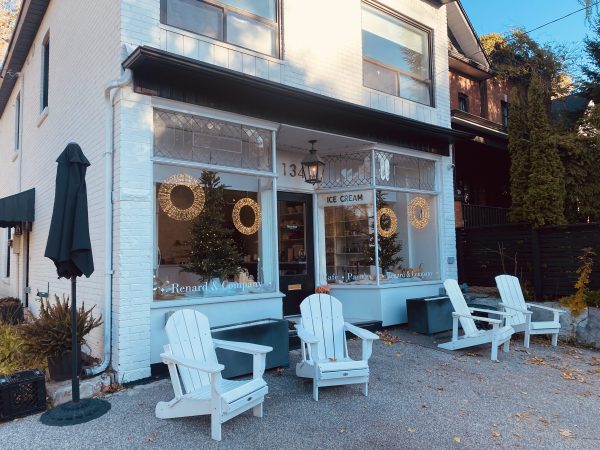I have lived for many years less than 30 metres from what was once one of Toronto’s storied corner stores — a green grocer known locally as “Dom’s” — for the owner, Domenico Cozzi.
He and his wife Rosa acquired the business, which is nestled in the middle of a (formerly working class) St. Clair West neighbourhood, from a Ukrainian war veteran in the 1960s. They were young immigrants from Italy, with three small children and family to support.
Dom told me once he bought it on a whim: he’d been working as a supermarket manager and opportunity knocked. The family, including a few stray relatives, lived upstairs. Dom and Rosa, a lovely couple, worked incredibly hard and paid off the mortgage in three years. Their business lasted for over 50 years, until COVID19. They went to live with one of their daughters during the pandemic. Then Rosa passed away, and Dom eventually sold the building to another local couple.
Their business model was basically to carry anything that anyone in the neighbourhood might want: produce, canned goods, dry goods, knick-knacks, stuff you didn’t think you needed until you needed it, an occasional bushel of salt cod. Dom drove his van to the Ontario Food Terminal most mornings, except Sundays, to load up. Yet I’m sure they made at least half their income selling sandwiches and candy to the kids in the middle school down the block. They were frequently urged to set up a patio out front, but refused. The cash register rarely closed.
The couple who bought the building managed, through some bureaucratic sleight of hand, to salvage Dom’s business license, which apparently was grandfathered as a legal non-conforming use. They gutted all three floors and eventually resurrected the retail portion as a kind of upscale mish-mash — some over-priced specialty foods, the inevitable quality coffee/pastries counter, plus, a bit incongruously, some interior decor items, with a showroom at the back (one of the owners is an interior designer). They remade the backyard into a little patio that attracts some customers in the warm months.
While the store’s positioning is unquestionably aligned with our neighbourhood’s very up-market demographic, it’s not a howling success; indeed, the owners tried to sell the building earlier this year, but took it off the market. They don’t do $3 sandwiches for school kids.
I mention this example because it’s an unusual instance of one of Toronto’s older/traditional in-neighbourhood businesses getting a (sort-of) second life, but it also offers some insight into the commercial challenges posed by resurrecting such venues.
With council yesterday having muddled through a reprise of the excruciating debate over neighbourhood retail, the story offers a bit of a cautionary tale: not in terms of the high-level planning objective (council absolutely should have allowed such uses everywhere, especially on major streets), but rather as an antidote to the nostalgic advocacy that informed much of the pro-neighbourhood business (a.k.a. corner-store of my childhood) side of this fight.
The compromised compromise, moved by Mayor Olivia Chow, passed 23-2. While Gord Perks, the architect of the deal, insisted otherwise, the new bylaw resembles the six-plex deal from the summer, with most parts of the older city opting in and most parts of the inner suburbs opting out. (This is essentially the triumph of urban form over zoning reform.)
Even for what we might call the pro-corner-store parts of the city, there are all sorts of conditions in the new bylaw, including some that seem extra super fussy (e.g., “a retail store may include an ancillary eating establishment or takeout eating establishment, provided that the preparation and sale of food and beverages is limited to cold and hot beverages and low-risk or pre-packaged, ready-to-eat food items“). Such businesses are only supposed to be established on so-called “community streets,” which is now a new designation in the zoning bylaw. Council also sent off requests to the province to disallow cannabis shops from becoming, well, neighbourhood convenience stores.
Perks’ deal includes portions of 30 major streets, many of them suburban, that will be exempted from the provisions allowing corner stores, which is a bit odd because some of these corridors have hosted local retail, including businesses in houses, for a long time. Other exempted streets are prime candidates for the sort of mid-rise and/or missing middle intensification envisioned in the city’s Expanding Housing Options Now campaign to add density in the Yellow Belt, and would be well-served in the future by more local retail venues. Oh well.
During the debate, downtowners talked about old-timey neighbourhood shops — barbers, local grocers, etc. — and walkable communities, while some suburban councillors went on about traffic and parking snarls. Scarborough Rouge Park’s Neethan Khan raised the prospect of some upstart local business that sells, say, beef patties becoming Instagram famous and then attracting hoards from the 905. (His hypothetical reads like a throw to the much-publicized complaints from two Queen West homeowners about the lines outside Pizzeria Badiali’s on Dovercourt.)
Stephen Holyday, as ever demonstrating his ignorance on so many urban topics, held up a photo of an Etobicoke strip mall by way of prop. “I bet the people that own these stores work really, really hard.” Correct. “I bet when the [shopkeepers] started their businesses, they had aspirations to grow even bigger.” Um, no. When those businesses started, the owners — mainly newcomers — mainly aspired to generate enough income to support their families.
If you squint hard and tune out the triumphalism of the all-but-Holyday majority vote, yesterday’s compromise looks distinctly status-quo-ish, except for the fact that in certain parts of the city, under certain exacting conditions, we’ll theoretically green light certain types of neighbourhood businesses, on certain streets, but only in certain locations.
The question to my mind is whether council has basically created little more than a golf-ball sized portal through which the notional entrepreneurs who populated this debate, at least rhetorically, must now navigate in order to establish their much-desired local businesses.
Since we’re talking about retail, I would be remiss not to quote the old joke about the three factors you need in order to succeed. The city’s legacy in-neighbourhood corner stores are situated, for the most part, in residential areas that once served large working class families in an era before big box supermarkets: location, location, and location. Those neighbourhoods, however, are now much less populous and a lot more expensive, so the prospect of starting something new likely involves a lot of upfront capital, all of it put at risk because there’s only going to be so much walk-by traffic.
(I don’t really count Badiali’s as a good example of this problem because its stretch of Dovercourt has long had retailers, and the location itself is also well-established as a business.)
At least in older neighbourhoods, there are corner store ghosts — buildings that once housed a green grocer, and presumably could be re-retailed. In `newer’ areas, by which I mean almost anything built since the 1930s, the city’s low-density residential built form plus the price of real estate will almost certainly doom even the savviest local retail business plan. No one’s going to be opening a convenience store or a barber shop or even a cute little bottle shop (!) on some corner in the middle of North Toronto or Don Mills. The math simply won’t work.
This has been the fate of the bougie new business in Dom’s. The proprietors haven’t been able to figure out how to get enough traffic into the store to justify whatever they spent on modernizing the place and readying it to serve St. Clair West’s fifth wave gentrifiers. Maybe the next owners will have a more marketable concept, but that remains to be seen.
Mainly, I find myself wondering whether this corner store debate has become a reprise of the food cart debacle from 15 years ago, when council cooked up a licensing program (“A la carte”!) so burdened with conditions (healthy food! fewer sausages! ethnic offerings!) that it almost immediately collapsed. In the spirit of collaborative decision-making, stakeholder awareness, and an expansive view of a business it didn’t understand, that earlier council made sure the entrepreneurs who were keen to jump into the emerging food truck market didn’t stand a chance.
I suspect we’ve probably just done the same thing.
Photo by John Lorinc





